![]()
![]()
T H E A R M E N I C S H I N A R S
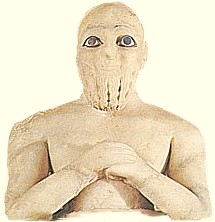
THE BRIGHT EYED ARMENIANS
WHO CALLED THEMSELVES AYAS
THE SACRED SEAL OF INNANA [ANAHIT -- THE MOTHER GODDESS]
AND EA-HAYA [ENKI]
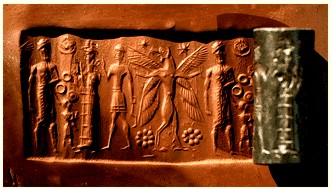
The Sumerians that were of Armenic or Armenid extraction had established one of the first centers of civilization in the lower part of Mesopotamia. Many scholars agree that Sumerians initially inhabited Armenian Highland and gradually descended to first Northern
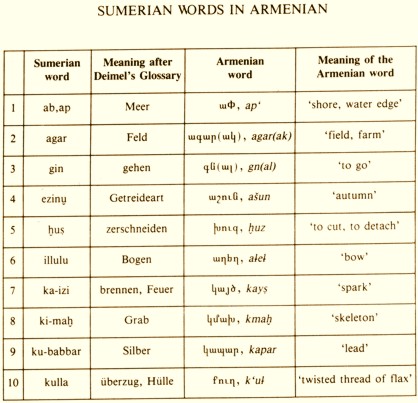
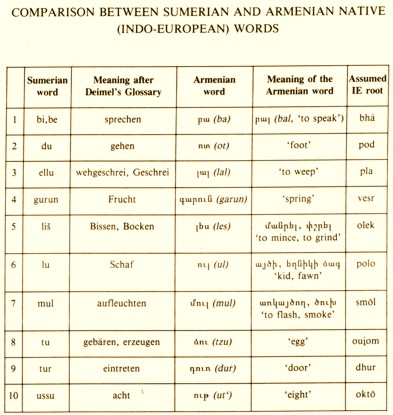
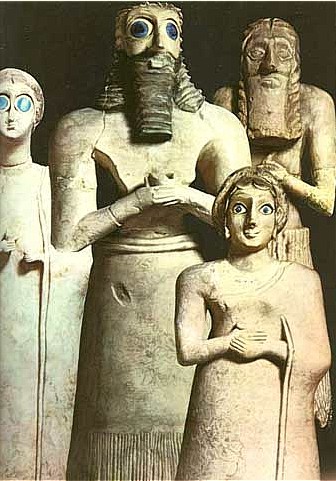
SOME OF THE COUNTLESS BEAUTIFUL SUMERIAN ARMENIC STATUES
WITH TRADEMARK LARGE EXPRESSIVE BRIGHT EYES...NOTE THE
CLASPED HANDS MUDRA ON CHEST [COMPLETE UNITY...].
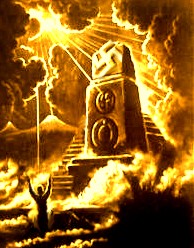
THE OBELISK OF METSAMOR NEAR THE ASTRONOMICAL OBSERVATORY.
Mesopotamia and eventually spread further south, establishing the cities of Ur [excavated by Sir Leonard Wooley in the 1920s], Uruk and Eridu [note the sacred variations -- AR-UR-ER-OR prefix]. Fortunately a number of Sumerian inscriptions dating from somewhere between 2750 and 2500 BC have been preserved. The Armenic Sumerians praised in their epics the Land of Aratta/Ararat as early as 28th century BC in one of the earliest inscriptions found. An American team excavating on the slopes of Mount Ararat found the proto-Sumerian writing system used by Armenians in the fourth millennium BC.
Among the artefacts uncovered in the royal tombs were evidences of great wealth; Gold, silver and bronze jewellery and adornments were found over and next to the body, which was placed in a sitting foetal position in a large stone sarcophagus (early Metsamor) or lying in a casket (late Metsamor). The bodies were laid out with their feet oriented towards the East, so they could greet the sun and follow it to the afterlife in the West. Included in the vaults were the skeletal remains of horses, cattle, domesticated dogs and humans, presumed to be servants or slaves to the deceased. The sacrifice of slaves and animals was a common feature of burial rituals during the Bronze and Early Iron Age, as they were considered necessary to assist their master in the next life. In addition to jewellery, pottery and tools, excavators discovered pots filled with grape and pear piths, grains, wine and oil. The fruit piths are a prominent part of the food offerings, and considered a necessary part of the funeral rites.
Other funeral objects discovered were rare amethyst bowls, ornamented wooden caskets with inlaid covers, glazed ceramic perfume bottles, and ornaments of gold, silver and semiprecious stones, and paste decorated with traditional mythological scenes typical of local art traditions. Egyptian, Central Asian and Babylonian objects were also found at the site, indicating that from earliest of times Metsamor was
one of the crucial epicenters of travel routes spanning the Ararat plain and linking Asia Minor with the North Caucasus and Central Asia. By the early Iron Age Metsamor was one of the royal city, an administrative-political and cultural center in the Ararat Valley.The walls date from the 2nd millennium BC, when the site was fortified during the era of the Kingdom of Van-Ararat. The stone blocks average 20 tons in weight, and are more than 3 meters thick in places.
zian script symbols (though carved at Metsamor much earlier, ca. 3,000 BC), and forms one of the basis' for establishing the old Armenian script during the Bronze Age around Metsamor.During the Middle Bronze Period (late 3rd to mid 2nd millennium BC) there was a surge of urban growth and a development of complex architectural forms which extended the boundaries of the settlement to the area below the hill. Basically, that area within the inner cyclopean walls are the older city, and that beyond represent newer areas. By the 11th c. BC the central city occupied the lowlands stretching to Lake Akna, and covered 100 hectares (247 acres).
En route to the temple site, just below the old citadel, is an incline on the stone hill. Carved into the hill is an intricate and large (almost 20 meters long) design. The design resembles a rudimentary map, and the shape of the rock resembles the Ararat side of Mt. Aragats in miniature. Inscriptions also include several early Haika
Three temples were uncovered and are now covered by a metal structure, Vandals have desecrated most of the altars you see. Luckily they are only three of an entire complex that was preserved by recovering them after the initial dig in 1967. The temples are unlike any other uncovered in Western Asia and the Ancient world, indicating a very distinct culture at Metsamor during the 2nd-1st millennia.
Within the altar spaces are numerous bowls set into the temple floor and a complex series of clay holders. Very little is understood about the ritual that occurred here, though animal sacrifice was a part. The holders probably held rare oil mixed with myrrh and frankincense, purified wine, wheat and fruit (seeds were discovered in some of the shallow bowls).
The astronomical observatory predates all other known observatories in the ancient world. That is, observatories that geometrically divided the heavens into constellations and assigned them fixed positions and symbolic design. Until the discovery of Metsamor it had been widely accepted that the Babylonians were the first astronomers. The observatory at Metsamor predates the Babylonian kingdom by 2000 years, and contains the first recorded example of dividing the year into 12 sections. Using an early form of geometry, the inhabitants of Metsamor were able to create both a calendar and envision the curve of the earth
.It should be no surprise to anyone who knows something of Armenia's history that astronomy is such an important part of the national character. Sun symbols, signs of the zodiac, and ancient calendars predominated in the region while the rest of the world was just coming alive, culturally speaking. Egypt and China were still untamed wilderness areas when the first cosmic symbols began appearing on the side of the Geghama Mountain Range around 7000 BC. At Metsamor (ca 5000 BC), one of the oldest observatories in the world can be found. It sits on the southern edge of the excavated city, a promontory of red volcanic rocks that juts out like the mast of a great ship into the heavens. Between 2800 and 2500 BCE at least three observatory platforms were carved from the rocks. The Metsamor observatory is an open book of ancient astronomy and sacred geometry. For the average visitor the carvings are indecipherable messages. With Elma Parsamian, the first to unlock the secrets of the Metsamor observatory as a guide, the world of the first astronomers comes alive.
Parsamian noted that "The Metsamorians were
a trade culture. For trade, you have to have
astronomy, to know how to navigate." The numerous inscriptions found at Metsamor
puzzled excavators, as indecipherable as they were elaborate. Hundreds of small
circular bowls were carved on the rock surfaces, connected by thin troughs or
indented lines. But one stood out. It is an odd shaped design that was a mystery
to the excavators of the site, until Professor Parsamian discovered it was a key
component to the large observatory complex. By taking a modern compass and
placing it on the carving, Parsamian found that it pointed due North, South and
East. It was one of the first compasses used in Ancient times.
Another carving on the platforms shows four stars inside a trapezium. The
imaginary end point of a line dissecting the trapezium matches the location of
star which gave rise to Egyptian, Babylonian and ancient Armenian religious
worship.
Sketch the locations of the Jupiter moons over several nights and you're
repeating an experiment Galileo did in 1610. Chart a star over several years and
you repeat an experiment the Metsamorians did almost 5000 years ago. By using
the trapezium carving and a 5000 year stellar calendar, Parsamian discovered
that the primary star which matched the coordinates of its end point was the
star Sirius, the brightest star in our galaxy.
"Sirius is most probably the
star worshipped by the ancient inhabitants of Metsamor," Parsamian explains.
"Between 2800-2600 BCE Sirius could have been observed from Metsamor in the
rising rays of the sun. It is possible that, like the ancient Egyptians, the
inhabitants of Metsamor related the first appearance of Sirius with the opening
of the year."
Those wanting to plot the same event from Metsamor will have to wait a while.
Sirius now appears in the winter sky, while the inhabitants of Metsamor observed
it in the summer. (Because of the earth's rotation within the rotation of the
Milky Way galaxy, stars change their positions over time. In another 4000 years
or so Sirius will again appear as it is plotted on the Metsamor stellar map).
The Metsamorians also left
behind a calendar divided into twelve months, and made allowances for the leap
year. Like the Egyptian calendar which had 365 days, every four years the
Metsamorians had to shift Sirius' rising from one day of the month to the next.
"There is so much I found in 1966," Parsamian adds, "and so much we do not know.
We believe they worshipped the star Sirius, but how? I like to imagine there was
a procession of people holding lights. These carved holes throughout the complex
may have been filled with oil and lit. Just imagine what it must have looked
like with all those little fires going all over the steps of the observatory.
Like a little constellation down on earth."
Parsamian has a special regard for Metsamor, since it was she who uncovered many
of the mysteries of the inscriptions on the observatory, answers which explained
other finds uncovered at the excavation site. "When you walk over this ancient
place, you can use your imagination to complete the picture. I love to visit
Metsamor since I feel I am returning to the ancients."
The observatory rivals the discoveries at the citadel for importance, substantiating theories on the birthplace of the zodiac and origins of astronomy in the ancient world. Dated ca. 2,800-2,500 BC, when the zodiac is figured to have been concluded, the observatory was also the primary religious site and navigation centre for the Metsamorian culture. Hundreds of shallow bowls are carved onto the surfaces of three large rocks that rise above the surrounding river delta. The use of the bowls are unknown, many are linked by equally shallow "canals" (we're talking real small here, no more than a few inches in diameter for the bowls). They might have been filled with oil that was lit at night as part of a ritual celebration (if so, they would look very much like a 'bowl of the universe' on earth), or they may have been used to smelt and forge metal in another sort of ritual. Imagination allows you to decide for yourself.
The author, accompanied by P.Herouni, his collaborators and two students from Moscow, spent the whole of 24 June, 2001, that is, two days after the summer solstice, on the spot from about 5 AM until midnight, and was able to observe and record with his personal video camera the rising of the Sun and the Moon. He witnessed that three or four of the holes are directed towards the point of sunrise while an equal number of other holes are oriented towards the point of sunset on the day of the summer solstice. The same is true of the points of the moon rising and setting on the day when the observations took place.
Livvio Stecchini noted the curious fact that Thebes in Egypt is geometrically aligned with Mt. Ararat, and the oracle centre called Dodona in Greece, both of which are recorded as resting places for the Ark, following the 'great flood'. He showed that the three sites are equidistant from each other, forming an equilateral triangle. This idea was later followed up by Robert Temple, who suggested that the nearby Metsamor was a more appropriate location as it is more accurately positioned than Ararat. The discoveries of advanced astronomy and geometry at this site, support the conclusion that Metsamor was once an important oracle center.
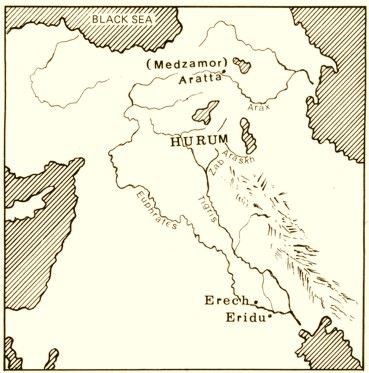
AR-MEN-IC LANDS OF ER-IDU --ER-ECH -- HUR-UM [LIT. LAND OF
FIERY MOUNTAINS]
-- AR-ATTA [AR-AR-AT-UR-AR-TU. METSAMOR OR MEDZAMOR
LITERALLY MEANS G R E A T M O T H E R'S...
Excavations began at Metsamor in 1965 and are still in progress, led by Professor Emma Khanzatian. The most recent excavation work occurred in the summer of 1996, along the inner cyclopic wall. Excavations have shown strata of occupancy going back to the Neolithic period (7,000-5,000 BC), but the most outstanding features of the site were constructed during the early, middle and late Bronze Ages (5000-2,000 BC). Inscriptions found within the excavation go back as far as the Neolithic period , and a sophisticated pictograph form of writing was developed by at least 2000-1800 BC if not earlier.
The excavation has uncovered a large metal industry, including a foundry with 2 kinds of blast furnaces (brick and in-ground). Metal processing at Metsamor was among the most sophisticated of its kind at that time: the foundry extracted and processed high-grade gold, copper, several types of bronze, manganese, zinc, strychnine, mercury and iron. Metsamorís processed metal was coveted by all nearby cultures, and found its way to Egypt, Central Asia and China. The iron smelting process was not advanced in Metsamor, probably due to the vast quantities of pure bronze alloys at hand, and Metsamor primarily mined and sold iron ore to neighbouring cultures.
The foundry dates from the Early Bronze Age (ca. 4,000 BC), though recent digs in the area uncovered signs of metal processing as early as 5,000 BC. The complex of smelting furnaces and moulds date from the mid Bronze to Early Iron Age (3,000-2,000 BC). The complex becomes more astounding the more you walk through it. Several huge underground caves were uncovered that are thought to have been storehouses for base metal, as well as a granaries for winter months. Stretching just below and around the Upper Citadel, the foundries processed Copper, Bronze, Iron, Mercury, Manganese, Strychnine, Zinc and gold. The first iron in the ancient world was probably forged here.
The discovery of thousands of people buried in simple graves and large burial mounds revealed a history of Metsamorís burial rituals and a concern for hiding wealthy tombs. Like the Pharaohs buried in the Valley of the Kings, Metsamorís rulers tried to thwart grave robbers by hiding the locations of royal tombs. Fortunately the grave robbers at Metsamor were not as lucky as those in Egypt, and the Mausoleums revealed intact and richly adorned burial vaults, giving us an excellent glimpse into the traditions for preparing the body for the afterlife.
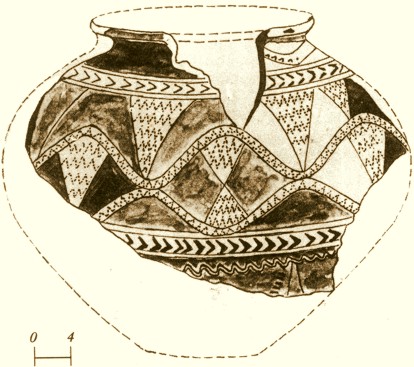
BEAUTIFULLY MADE JAR FROM METSAMOR
WITH HARMONIC ORNAMENTS THAT BARE STRIKING
SIMILARITY OF GEOMETRIC SYMBOLS AND
PATTERN AS THE CERAMICS FROM MONTSERRAT.
OPENING EYE/WOMB/VULVA/∞/SERPENTS
IN BETWEEN PARALLEL
RUNNING HORIZONTAL LINES [WITH HORIZ. 'V' CHEVRONS].
CONVERGING UP AND DOWN TRIANGLES/DIAMONDS/RHOMBI
AND UNITED ZIGZAG RUNNING 'MWs....'
SECOND MILLENNIUM BC.

SOLAR CROSS MEDALLION FROM METSAMOR.
FOUR DIVERGENT TRIANGLES LEADING
TO THE CIRCLE IN THE CENTER.
SECOND MILLENNIUM BC.
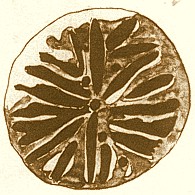
FORM STAMP FOR MARKING BAKED BREAD
IN THE SACRED PATTERN SYMBOLIC OF THE
GODDESS [SIRIUS]. CA. 1300-1000 BC.
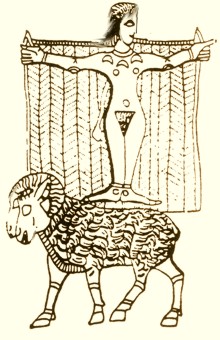
HAYASAN-HITTITE GODDESS [PROBABLY TI-KIN OR DEU/DEV-KIN...KEANK
LIT. DIVINE OR GODLY LIFE [GIVER]] KUM-BABA AS THE
GUARDIAN OF MYSTERIES. THE GODDESS STANDS ON TOP OF THE
RAM [GOLDEN FLEECE...] AND THROUGH SER [UNCONDITIONAL
ALL-EMBRACING LOVE] UNVEILS COSMIC TRUTHS TO THOSE THAT START
TO SEE BEYOND THE [PHYSICAL] VEIL. NOTE THE PUBIC HAIR IN THE
SHAPE OF THE DOWNWARD POINTING DELTA. MARKED NAVEL...
AND AMULET MADE UP OF THREE CRESCENTS. MARASH. CA. 1150 BC.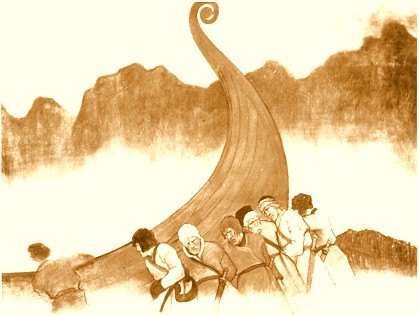
LET HER SAIL...
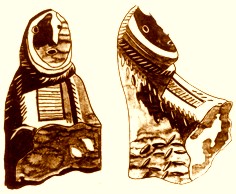
REMNANT OF A STATUETTE OF THE MOTHER GODDESS FROM
ONE OF THE HOMES IN METSAMOR. CA. 1300-1000 BC.
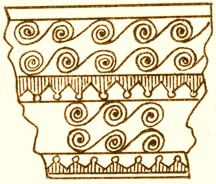
ARMIN WARRIOR'S BRONZE BELT FROM SECOND MILLENNIUM BC
DECORATED WITH PAROYRS [SPIRALS] IN 69-MALE-FEMALE PATTERN.
THE SPIRALING [AQUARIAN] WAVES...GIVE BIRTH TO
THE SOLAR FOUR-ARMED SQUARE. NOTE THE TRIANGLES
CAPPED WITH THE ONE RING [ETERNITY].
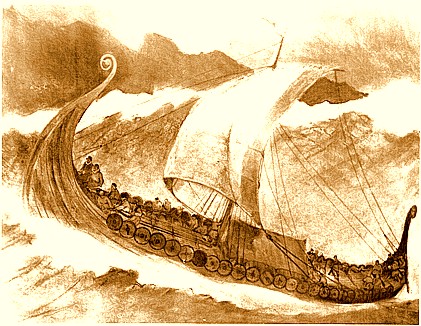
THE GREAT DRAGON SHIPS INCLUDED RIGHT AND LEFT SPINNING SPIRALS
[AYA-INANNA] AT THE TIPPING HORNS OF THE VESSEL [AQUARIAN-COSMIC
CONNECTION WITH THE GODDESS].
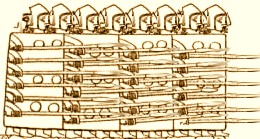
ARMAN DEFENSIVE WARRIOR FORMATION FROM URUK.
SCENES ARE SIMILAR TO THOSE OF
STANDARD OF UR IN WHICH
THE CENTRAL PANEL OF THE TRIPLE-DECKER 'WAR' SIDE OF THE TRIPLE-DECKER
PANEL [THE OTHER SIDE AGAIN DIVIDED
INTO THREE HORIZ. PARTS DEPICTS TRANQUIL SCENES OF EVERYDAY LIFE
INCLUDING ROYAL FEASTING CATTLE HERDING AND GATHERING OF CROPS
-- AND HENCE HAS BEEN APPROPRIATELY COINED 'PEACE...']
. CA. 2,600 BC. EXCAVATED BY THE GREAT SIR LEONARD WOOLLEY.
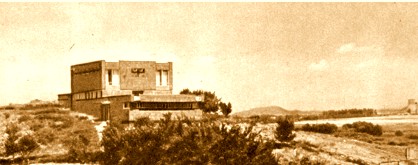
THE MUSEUM OF ANTIQUITIES IN METSAMOR HOUSES SOME OF THE
MOST
IMPORTANT ARTIFACTS OF THE PRIMORDIAL METALLURGICAL SMELTING
CENTER.
LIKE THE EREBUNI MUSEUM A QUADRANGLE ARCHITECTURAL DESIGN.
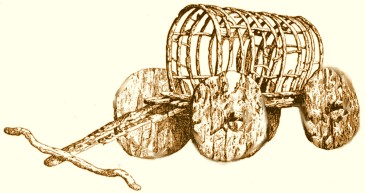
THE REMARKABLY WELL PRESERVED [OLDEST SURVIVING] WAGON
FROM LCHASHEN DIG. CA. 1,800 BC. PRESERVED THANKS TO THE TAR
THAT COVERED THE WAGON THAT WAS INITIALLY UNDER
THE WATERS OF LAKE SEVAN. AS THE WATERS OF THE GIANT LAKE
BEGAN TO RECEDE THE REMARKABLE ARCHAEOLOGICAL SITE WAS DISCOVERED.
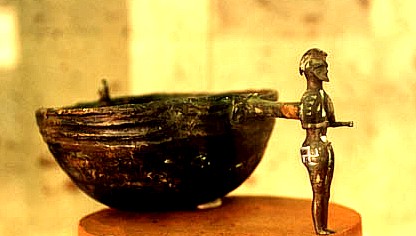
LORI CASTLE. BRONZE LADLE WITH THE STATUETTE OF HELMETED WARRIOR
WITH AN ERECTED PHALLUS AND A 'TATTOO' OF A SWASTIKA [AS THE WARRIOR
MOST PROBABLY HAD] ON THE RIGHT LIMIT. SECOND MILLENNIUM BC.
They give us a fascinating glimpse into the Sumerian origins and culture. In the great Epic of Gilgamesh, the Sumerians recount the land of their ancestors, the Arattans in the Highlands of Armenia. Most scholars agree that Aratta [Suburi - Sumerians also known as Suberians and called themselves Shinar[ar]s] was in fact the first Indo-European state that existed in the first half of the third millennium BC. Archaeology has revealed that in Metsamor, between 2,800-2,600 BC, astronomer scientist high priests observed the rising of Sirius, and worshiped it. Sirius [Dog Star] symbolically stood for Matron Goddess Aya-Inanna-Ninhursag [later Anahit] of Aratta. Enmerkar, the grandfather of the hero Gilgamesh lived around 2,750 BC and the King of Aratta through his herald sent a message to Enmerkar stating that Inanna had not abandoned neither Aratta nor her house therein -- the Ziggurat Temple that was a primordial astronomical observatory and an origin site of metal smelting foundries...

![]()
![]()